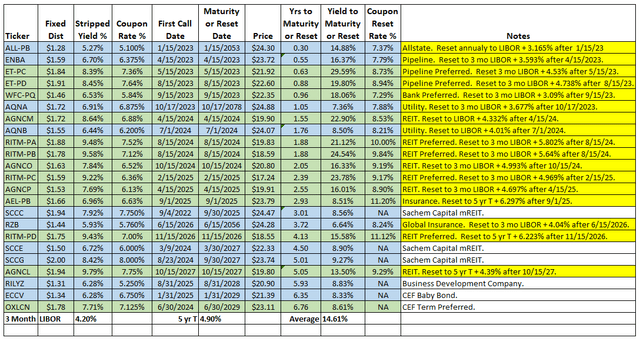cagkansayin
Introduction
Global central bankers as well as our own Federal Reserve have been aggressively pushing up short-term interest rates and implementing tight money policies (Quantitative Tightening in the US) to push inflation back down towards their respective targets (~2% in the US). These tight money policies are pushing up fixed income yields and pushing down fixed income securities’ valuations.
The Federal Reserve recently made it clear that aggressive tight money policies will be pursued and maintained until inflation has been tamed. In other words, we are likely going to see interest rates higher for longer than most market participants were expecting a month ago. This realization turned market sentiment strongly negative, and both the bond market and stock market have been selling off.
While common stocks are sporting lower valuations than a month ago and, in many cases, lower than a year ago, I don’t believe they are cheap yet. We will likely see common stocks with yet lower valuations. Given this tough investing environment, where do we look for decent and reasonably safe returns? If we sit on cash and earn 2-3% and still be getting negative real returns with inflation running around 8%. This article presents a better option that will provide positive real returns while we wait for the Fed to slay the inflation dragon.
Bond Ladder
I’m using a bond (and a few preferred issues) ladder to generate decent returns with relatively low risk. The concept is simple. Invest in baby bonds and preferred issues that have a near term maturity or expected call date from one to six years out. As those securities mature or get called, roll the proceeds into newer fixed income securities or common stocks depending on the current market environment. A bit of a side note here is probably warranted. I’m rather flexible with my investment mix and do not follow a rigid 60/40 or 50/50 split between stocks and fixed income. Sometimes the market environment is well suited to common stock investments and sometimes it is better suited towards fixed income. Today, I believe, fixed income will provide the best investment returns for the time being.
Below is the summary of my current progress on a fixed income ladder. Readers should note that this is a work in progress, and I’ll be adding additional securities to this ladder.
Bond/Preferred Ladder (Author)
The securities listed are all exchange traded debt or preferred stocks, therefore easily bought and sold. Some of these securities have low trading volumes (e.g. a few thousand a day). To deal with the low trading volumes, I have been using good-till-cancelled (GTC) limit orders for a few hundred shares at a time priced a percent or so below the current asking price. As I mentioned earlier in the article, I’m currently accumulating shares/bonds from the above list. The baby bonds are highlighted in light blue and preferred stocks in light green. The yellow highlight in the notes section is to call attention to the fixed-to-float (FTF) or reset rate of some of the securities.
The baby bonds (light blue highlight) in the table above have a defined maturity date as does the single, term preferred security (OXLCPN). I used those maturity dates for the YTM calculation. Other than OXLCN, the preferred shares in the table above all have either FTF rates or a reset rate. I used the reset date, which is typically also the first call date, to calculate the YTC. Note that all the reset rates are at least 120 basis points above the original coupon rate with many significantly higher. Whether or not those FTF and reset rate preferred securities are called on or shortly after their call date will depend on the current cost of new money and the current LIBOR rate or 5-year Treasury Bill rate which determines the rate at reset.
The current three-month LIBOR and 5-year T-bill rates are 3.6% and 3.96% respectively. Both are expected to continue to rise through 2023 to a range of 4-5% for three-month LIBOR and 4.5-5.5% for the 5-year T-bill. If the Federal Reserve is successful in getting inflation back down to their 2% target, three-month LIBOR, or SOFR by that time, and the 5-year T-bill rates will begin to slowly moderate in the second half of 2024. That rate projection is obviously highly uncertain and will depend on how the economy and inflation behave over the next year. As can be seen at the bottom of the table above, I chose a three-month LIBOR rate of 4% and a 5-year T-bill rate of 4.9% for the FTF and reset rate estimates. Keep in mind that both the cost of new money as well as the FTF and reset rates will be dependent on the current market rates (LIBOR and T-bill). So, if the projections are a bit off, the effect on the decision to call in existing securities will be limited.
Double-Digit Return
A quick scan down the YTM/YTC and Reset Yield columns of the table above shows several securities offering double-digit returns. As an investor, you will either get the YTC return if the security is called or the Reset Yield if the security is not called and you continue to hold the security after the Call/Reset date. Finding a guaranteed double-digit return on securities that stand in front of the common stock in the capital stack is a pretty good deal and doesn’t come around that often. I’m actively building out my fixed income ladder using these securities.
Investors less interested in building a bond ladder and more focused on maximizing total return could pick the securities listed above with the highest YTM/YTC giving an average YTC approaching 15%. That is a very solid return for fixed income securities. Note that the preferred share market and the baby bond market are uncharacteristically volatile at this time. By the time this is published, the current prices and yields will be different.
Conclusion
Investors today have an opportunity that hasn’t been available for more than a decade – the possibility of generating double-digit returns on securities that carry lower inherent risk than the corresponding common shares. Preferred stock stands at the front of the line for dividend payments. Common shareholders cannot receive a penny of dividends unless the preferred shareholders are receiving their full dividend payment. This makes preferred stock a lower risk investment than the common stock. Baby bonds carry even less risk, as they are senior to both the common stock and preferred stock in the event a company defaults. Failing the timely payment of interest on baby bonds would also cause a company to be in default. Double-digit returns on these types of securities is a rare event and active investors would do well to take advantage of this unique opportunity.


Be the first to comment